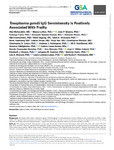Toxoplasma gondii IgG serointensity is positively associated with frailty

Ver/Abrir
Use este enlace para citar
http://hdl.handle.net/2183/35008
Excepto si se señala otra cosa, la licencia del ítem se describe como Creative Commons Attribution-NonCommercial-NoDerivs 4.0 International License (CC-BY-NC-ND 4.0)
Colecciones
- Investigación (FCS) [1295]
Metadatos
Mostrar el registro completo del ítemTítulo
Toxoplasma gondii IgG serointensity is positively associated with frailtyAutor(es)
Fecha
2023-11-06Cita bibliográfica
Mohyuddin H, Laffon B, Teixeira JP, Costa S, Teixeira-Gomes A, Pásaro E, Constantine N, Dagdag A, Ortmeyer HK, Tizenberg B, Afram L, Yen P, Marano C, Lowry CA, Hoisington AJ, RachBeisel JA, Valdiglesias V, Lema-Arranz C, Fernández-Bertólez N, Maseda A, Millán-Calenti JC, Kovacs EJ, Gostner JM, Fuchs D, Brenner LA, Lorenzo-López L, Postolache TT. Toxoplasma gondii IgG Serointensity Is Positively Associated With Frailty. J Gerontol A Biol Sci Med Sci. 2024 Mar 1;79(3):glad228.
Resumen
[Abstract] Background: Persistent inflammation related to aging ("inflammaging") is exacerbated by chronic infections and contributes to frailty in older adults. We hypothesized associations between Toxoplasma gondii (T. gondii), a common parasite causing an oligosymptomatic unremitting infection, and frailty, and secondarily between T. gondii and previously reported markers of immune activation in frailty.
Methods: We analyzed available demographic, social, and clinical data in Spanish and Portuguese older adults [N = 601; age: mean (SD) 77.3 (8.0); 61% women]. Plasma T. gondii immunoglobulin G (IgG) serointensity was measured with an enzyme-linked immunosorbent assay. The Fried criteria were used to define frailty status. Validated translations of Mini-Mental State Examination, Geriatric Depression Scale, and the Charlson Comorbidity Index were used to evaluate confounders. Previously analyzed biomarkers that were significantly associated with frailty in both prior reports and the current study, and also related to T. gondii serointensity, were further accounted for in multivariable logistic models with frailty as outcome.
Results: In T. gondii-seropositives, there was a significant positive association between T. gondii IgG serointensity and frailty, accounting for age (p = .0002), and resisting adjustment for multiple successive confounders. Among biomarkers linked with frailty, kynurenine/tryptophan and soluble tumor necrosis factor receptor II were positively associated with T. gondii serointensity in seropositives (p < .05). Associations with other biomarkers were not significant.
Conclusions: This first reported association between T. gondii and frailty is limited by a cross-sectional design and warrants replication. While certain biomarkers of inflammaging were associated with both T. gondii IgG serointensity and frailty, they did not fully mediate the T. gondii-frailty association.
Palabras clave
Chronic toxoplasmosis
Inflamagging
Kynurenine to tryptophan ratio
sTNF-RII
Inflamagging
Kynurenine to tryptophan ratio
sTNF-RII
Versión del editor
Derechos
Creative Commons Attribution-NonCommercial-NoDerivs 4.0 International License (CC-BY-NC-ND 4.0)
ISSN
1079-5006






